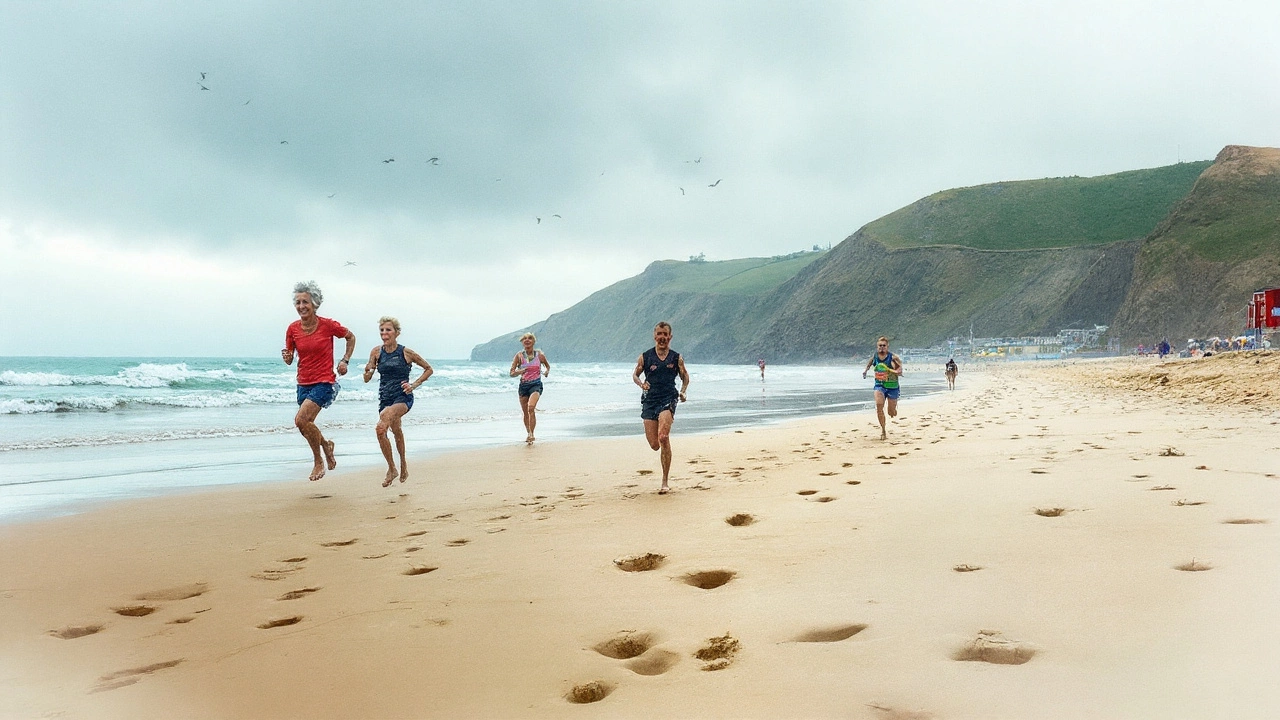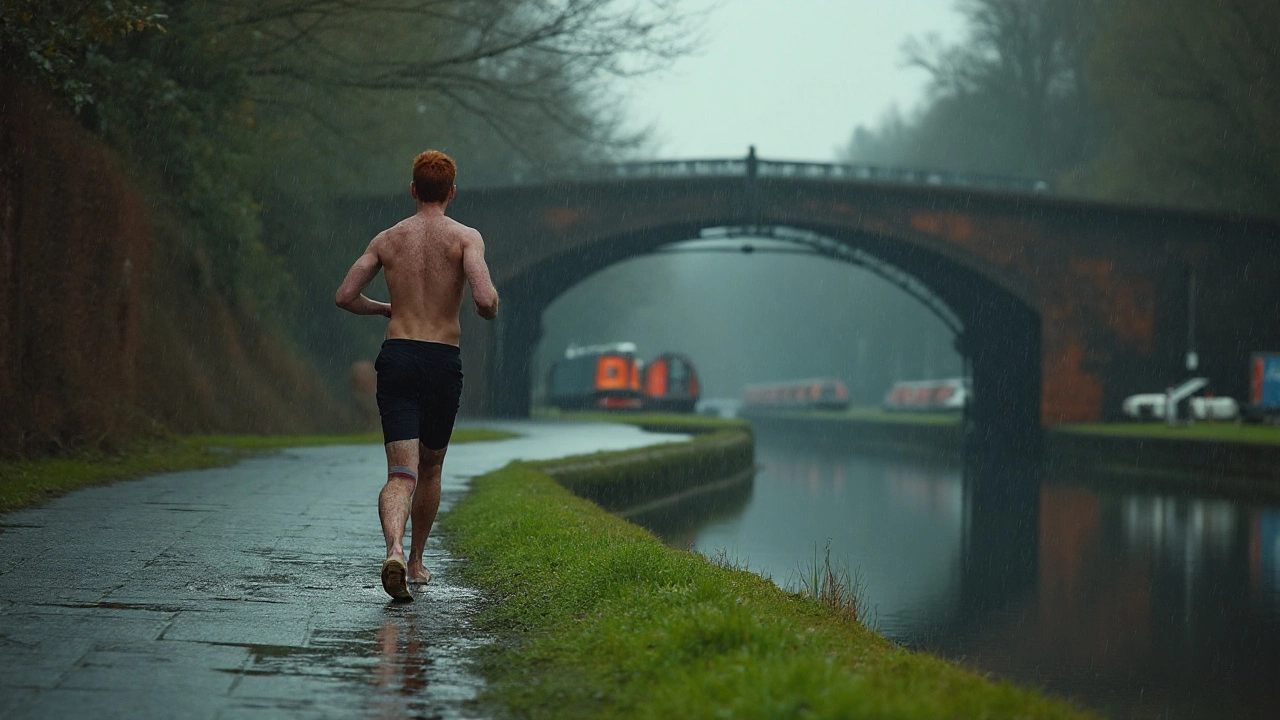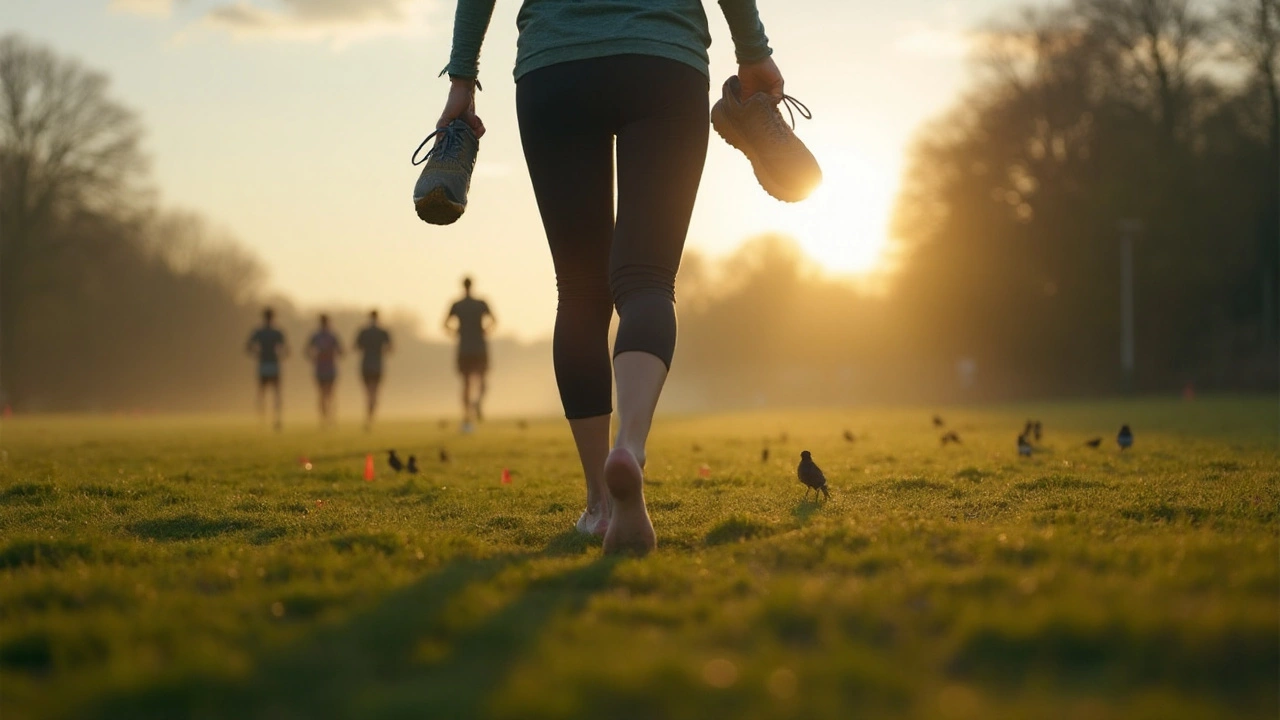Kick your shoes off and your running changes in seconds: your stride tightens, your cadence ticks up, and your calves clock in for overtime. That can feel freeing-or punishing-depending on how you do it. This guide explains what actually happens when you run without running shoes, where the risks sit, and how to experiment safely without wrecking your feet or your training.
TL;DR: What happens if you run without running shoes?
Here’s the short version before we go deeper.
- Your stride shifts: most people move toward a mid/forefoot strike, higher cadence, and shorter steps. This can reduce the sharp impact spike but increases load on the calf-Achilles complex.
- Foot muscles work harder: intrinsic foot muscles and the arch get a bigger job, which can build strength over time-but it’s easy to overdo early and irritate the plantar fascia or metatarsals.
- Surface matters more than ever: smooth grass and rubber tracks are friendly; hot asphalt, chip seal, and debris are not. Your soles will tell you the truth quickly.
- Injury risk shifts, not disappears: you may trade knee niggles for calf/Achilles soreness if your build-up is too fast. A careful ramp is non-negotiable.
- Start tiny: think minutes, not miles. Add barefoot minutes weekly, cap at 10-20% of your total volume for the first 8-12 weeks, and only progress if you feel normal two days later.
What actually changes in your body and stride
When you run without cushioned shoes, your brain protects you by changing how you land. Most runners shift from a rearfoot strike toward a midfoot or forefoot landing with a quicker cadence and a shorter step. That doesn’t happen because you decide it; it happens because hard ground and bare skin make overstriding feel awful. The sensory feedback is instant.
Mechanically, that switch can cut the sharp impact transient often seen with a long-heel strike, but the load moves elsewhere. The calf and Achilles take more eccentric load, the foot’s arch becomes a spring, and your ankle joint works through a bigger range. Researchers have measured a 5-10% rise in cadence and shorter ground contact time in habitual barefoot patterns compared to shod, which helps spread forces over time rather than all at once.
What about the knees and hips? Some runners notice less patellofemoral stress when they stop overstriding, because the foot lands under the hips with a softer knee. But this is a trade, not a cure-all. If your calves and Achilles aren’t conditioned, they complain first. That’s why a slow ramp is everything.
Energy cost is a mixed bag. At first, running barefoot can feel more expensive metabolically because new muscles are working and your form isn’t efficient yet. Over a few months, some people even up or improve a touch as their foot strength grows. The short-term reality: expect sore calves and tender soles in week one. That’s normal. Sharp, localized bone pain? Not normal-stop and give it a few days.
On the tissue side, your plantar skin adapts within weeks, but bones and tendons adapt slower. Bone remodeling can take 8-12 weeks to catch up with new stress patterns. That lag is why overuse injuries, like metatarsal stress reactions or Achilles tendinopathy, often show up in months 2-3, not day three. Keep that timeline in mind.
A few landmark findings to anchor expectations:
- Cadence tends to rise 5-10% when barefoot, with shorter stride length (Bonacci et al., 2013; Fuller et al., 2015).
- Forefoot/midfoot landings reduce the sharp impact spike but increase ankle and Achilles loading (Lieberman et al., 2010; Warne & Gruber, 2017 review).
- Transitioning too fast raises stress fracture risk, especially in the metatarsals (Ridge et al., 2013).
- Foot intrinsic muscles hypertrophy with barefoot/minimalist exposure, improving arch stiffness over time (Johnson et al., 2014).
None of this says barefoot is better or worse. It’s different. If you’ve got cranky knees from a long overstride, a small dose of running without shoes can be a smart tool. If your Achilles has a history, you’ll need an even slower ramp-or you may decide it’s not worth it.

How to try it safely: a simple, progressive plan
Think minutes, not miles. Your goal isn’t a barefoot badge; it’s stronger feet, cleaner mechanics, and zero injuries. Use this as a template and adjust based on how you feel two days later.
- Prep week (daily): Walk barefoot around the house and on smooth grass for 10-20 minutes. Add 2-3 sets of these: calf raises (straight and bent knee, 12-15 reps), toe yoga (lift big toe, then small toes), short foot/arch doming (hold 5-10 seconds), and gentle ankle mobility. If anything hurts beyond mild muscle work, back off.
- Week 1: After an easy run in shoes, do 2-3 x 30-60 seconds barefoot strides on smooth grass, walking 1-2 minutes between. Keep it relaxed. Check your calves the next morning-mild soreness is fine, sharp pain is not.
- Week 2: 3-4 x 60-90 seconds barefoot strides. Add one 5-minute barefoot walk post-run. Keep your regular running volume and workouts in shoes.
- Week 3: One short add-on: 5-8 minutes continuous barefoot jog on grass, once this week. Plus 3-4 strides on a second day. If you feel 100% normal 48 hours later, you can progress.
- Week 4: 8-10 minutes continuous barefoot jog once; 4-6 strides on another day. Total barefoot time still under 10% of your weekly run time.
- Weeks 5-8: Add 2-3 minutes barefoot per week, up to 15-20 minutes continuous once or twice weekly. Keep total barefoot under 15-20% of weekly volume. If you want to try smooth asphalt, limit it to the last 3-5 minutes of a run and scan the surface.
Key cues while you run:
- Quiet feet: if you can hear slaps, shorten the step and land softer.
- Foot under hips: imagine your foot touching down below your center, not out in front.
- Cadence: aim for ~170-180 steps per minute as a starting point, but don’t force it-let it rise naturally with shorter steps.
- Posture: tall through the torso, slight forward lean from the ankles, not the waist.
Surface progression:
- Weeks 1-4: smooth, closely cut grass or a rubber track infield.
- Weeks 5-8: add smooth asphalt for tiny doses; still avoid chip seal and hot surfaces.
- After 8+ weeks: mix in hard-packed dirt you’ve already walked to check debris.
If/then rules to stay safe:
- If soreness (2-3/10) is gone within 48 hours: repeat the last dose or add 1-2 minutes.
- If soreness lingers 72+ hours or localizes (sharp spot): take 3-5 days off barefoot, drop back one step when you return.
- If you feel burning under the forefoot while running: stop for the day-your skin and tissues need time.
- If Achilles feels tight in the morning: switch to walking-only barefoot for a week and add more bent-knee calf raises.
Helpful warm-up (3 minutes total): 30 seconds ankle circles each way, 20 calf hops, 10 walking lunges, 10 straight-knee calf raises, 10 bent-knee calf raises. Simple works.
How to use minimalist shoes as a bridge: if fully barefoot makes you anxious, start with thin, flexible shoes (stack < 15 mm, drop 0-4 mm). They protect the skin while letting your body learn a softer landing. Keep the same time-based progression.
Where, when, and who: surfaces, conditions, and fit
Running barefoot puts your nervous system on high alert-in a good way. That makes surface choice and conditions non-negotiable early on.
- Best early surfaces: smooth grass, turf soccer fields, rubber track infields. These teach soft landings without tearing your skin.
- Better later: smooth asphalt and well-groomed dirt paths. Add tiny doses and scan visually.
- Avoid early: chip seal, rocky trails, hot pavement, and any surface you haven’t walked first.
- Weather watch: heat softens skin and burns; cold numbs your feedback and slows reaction. Moderate temps are your friend.
Who it suits:
- Curious runners with time to build slowly, especially if you want to tidy up an overstride or wake up sleepy feet.
- Runners with recurring knee niggles who want another tool to change load patterns.
Who should be cautious or skip:
- History of Achilles or calf tears, severe plantar fasciitis, or recent metatarsal stress injury.
- Peripheral neuropathy, diabetes with reduced foot sensation, or anyone on blood thinners (higher risk from small cuts).
- Big mileage build or racing block in the next 8-12 weeks-save the experiment for a quiet training phase.
| Factor | With Cushioned Shoes | Without Shoes | What It Means |
|---|---|---|---|
| Foot strike | Often rearfoot | Often mid/forefoot | Impact spike may drop; ankle/Achilles load rises |
| Cadence | 160-175 spm typical | +5-10% increase common | Shorter steps, less overstride, softer landings |
| Ground feel | Muted | High | Great feedback; higher risk from debris/heat/cold |
| Knee load | Moderate-high if overstriding | Can be lower | Helpful for some with patellofemoral pain |
| Calf/Achilles load | Moderate | Higher | Needs slow adaptation; eccentric strength helps |
| Skin protection | High | None | Choose safe surfaces; stop at hot spots |
| Transition time | None | 8-12 weeks minimum | Bones/tendons adapt slower than skin |
Gear options if you want a middle ground:
- Minimalist shoes: thin, flexible, low drop. Good “training wheels.”
- Beach socks or foot sleeves: protect the skin on turf or sand without changing mechanics much.
- Huarache-style sandals: allow toe splay and ground feel with just enough protection.

Common problems, fixes, FAQ, and next steps
Most hiccups are predictable. Fix the cause, not just the symptom, and you’ll keep the gains.
Hot spots and blisters under the forefoot:
- Why: too much time too soon; gripping with the toes; rough surface.
- Fix: stop for the day at first sign; add 3-5 days of walking-only barefoot; practice relaxed toe splay; return on smoother grass.
Calf tightness or Achilles ache (morning stiffness):
- Why: ankle and Achilles taking new load; big jumps in barefoot time.
- Fix: 7-10 days with only strides (no continuous barefoot runs); add bent-knee calf raises and slow eccentric lowers; avoid uphill barefoot.
Top-of-foot ache or sharp pain on a metatarsal:
- Why: bones not yet adapted; excessive forefoot loading.
- Fix: stop barefoot immediately; switch to minimalist or regular shoes for 2-3 weeks; see a clinician if pain persists or worsens with walking.
Plantar fascia twinges at the heel:
- Why: foot muscles/plantar tissue overloaded.
- Fix: short foot drills, towel curls, and controlled loading; roll the calf, not just the arch; reduce barefoot time until pain-free.
Form goes sloppy when tired:
- Why: fatigue lowers cadence and increases overstride.
- Fix: end the barefoot segment before fatigue; finish in shoes; keep doses short and sharp.
Quick checklist before any barefoot session:
- Surface checked by sight or a short walk.
- Warm-up done (3 minutes is fine).
- Plan is time-based, not distance.
- Stop at the first hot spot or sharp pain.
- Next-day feel test: no lingering pain? You can repeat.
Mini‑FAQ
- Will barefoot running fix my knee pain? It can reduce knee load for some by cutting overstride, but it may shift stress to your calves and Achilles. Try small doses and monitor how you feel two days later.
- Is it faster? Not by itself. Some runners find improved economy after months of adaptation; many feel slower early on. Treat it as a form and strength tool.
- How far is safe? Early on, 5-10 minutes tops. Even experienced barefoot runners often cap it or use it for strides and drills.
- Can I run barefoot on a treadmill? Yes, but only on a clean belt. Heat friction can be an issue-keep sessions short and check your skin.
- What about orthotics? Barefoot and orthotics serve different jobs. If you rely on orthotics for a diagnosed issue, talk to a clinician before experimenting.
Next steps and troubleshooting by persona:
- Beginner runner: keep all barefoot work to strides for 4-6 weeks. Your aerobic engine and tissues are both new-one variable at a time.
- Marathoner in base phase: use 2 x 6-10 minutes barefoot per week on grass as a strength/form session. Drop it 4-6 weeks out from race day to simplify training stress.
- Trail runner: stick to field turf and smooth dirt loops. Save rocky trails for shoes or sandals until your soles and foot bones are seasoned.
- History of Achilles issues: try minimalist shoes before fully barefoot, keep all barefoot running flat, add heavy slow resistance calf work 2x/week.
- Hot climate: run early morning or evenings; test the ground with your palm. If it’s too hot to keep your hand there, it’s too hot for your feet.
Evidence notes for the curious: Daniel Lieberman’s 2010 work spotlighted how landing patterns change with and without shoes. Daoud (2012) linked repetitive impact loading with injury risk profiles in collegiate runners. Warne & Gruber’s 2017 review summarized adaptations and injury considerations in minimalist/barefoot running. Ridge (2013) warned about metatarsal stress when transitioning too quickly. Different studies, same story: change the load, change the risk-so change slowly.
If you take nothing else from this: start tiny, listen to your calves and soles, and let comfort and recovery guide the next step. Barefoot can be a great tool-not a magic trick.
